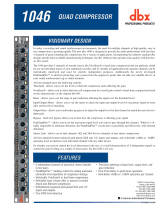The dbx MC6 Mini-Comp is a professional quality stereo compressor that provides traditional dbx sonic quality and performance for a variety of uses, including reducing and controlling dynamic range, adding punch to flabby sounds, or adding sustain to instruments. It features two Auto compression modes optimized for vocals and instruments, True RMS Power Summing for accurate stereo imaging, and AutoDynamic circuitry for a wide range of compression voicings.
The dbx MC6 Mini-Comp is a professional quality stereo compressor that provides traditional dbx sonic quality and performance for a variety of uses, including reducing and controlling dynamic range, adding punch to flabby sounds, or adding sustain to instruments. It features two Auto compression modes optimized for vocals and instruments, True RMS Power Summing for accurate stereo imaging, and AutoDynamic circuitry for a wide range of compression voicings.
















-
 1
1
-
 2
2
-
 3
3
-
 4
4
-
 5
5
-
 6
6
-
 7
7
-
 8
8
-
 9
9
-
 10
10
-
 11
11
-
 12
12
-
 13
13
-
 14
14
-
 15
15
-
 16
16
The dbx MC6 Mini-Comp is a professional quality stereo compressor that provides traditional dbx sonic quality and performance for a variety of uses, including reducing and controlling dynamic range, adding punch to flabby sounds, or adding sustain to instruments. It features two Auto compression modes optimized for vocals and instruments, True RMS Power Summing for accurate stereo imaging, and AutoDynamic circuitry for a wide range of compression voicings.
Ask a question and I''ll find the answer in the document
Finding information in a document is now easier with AI
Related papers
Other documents
-
Focusrite Green 6 Quad Compressor Limiter User guide
-
Kicker Dynamic Range Compression Owner's manual
-
Harman Kardon 18-0840 User manual
-
 dbx Pro fessional Products Air Compressor 1046 User manual
dbx Pro fessional Products Air Compressor 1046 User manual
-
API Audio Tranzformer LX Owner's manual
-
Fender Micro Comp User manual
-
API Audio Tranzformer GT Owner's manual
-
Universal Audio LA-2A Owner's manual
-
Fender Micro EQ Owner's manual
-
Waves DeBreath Owner's manual

















